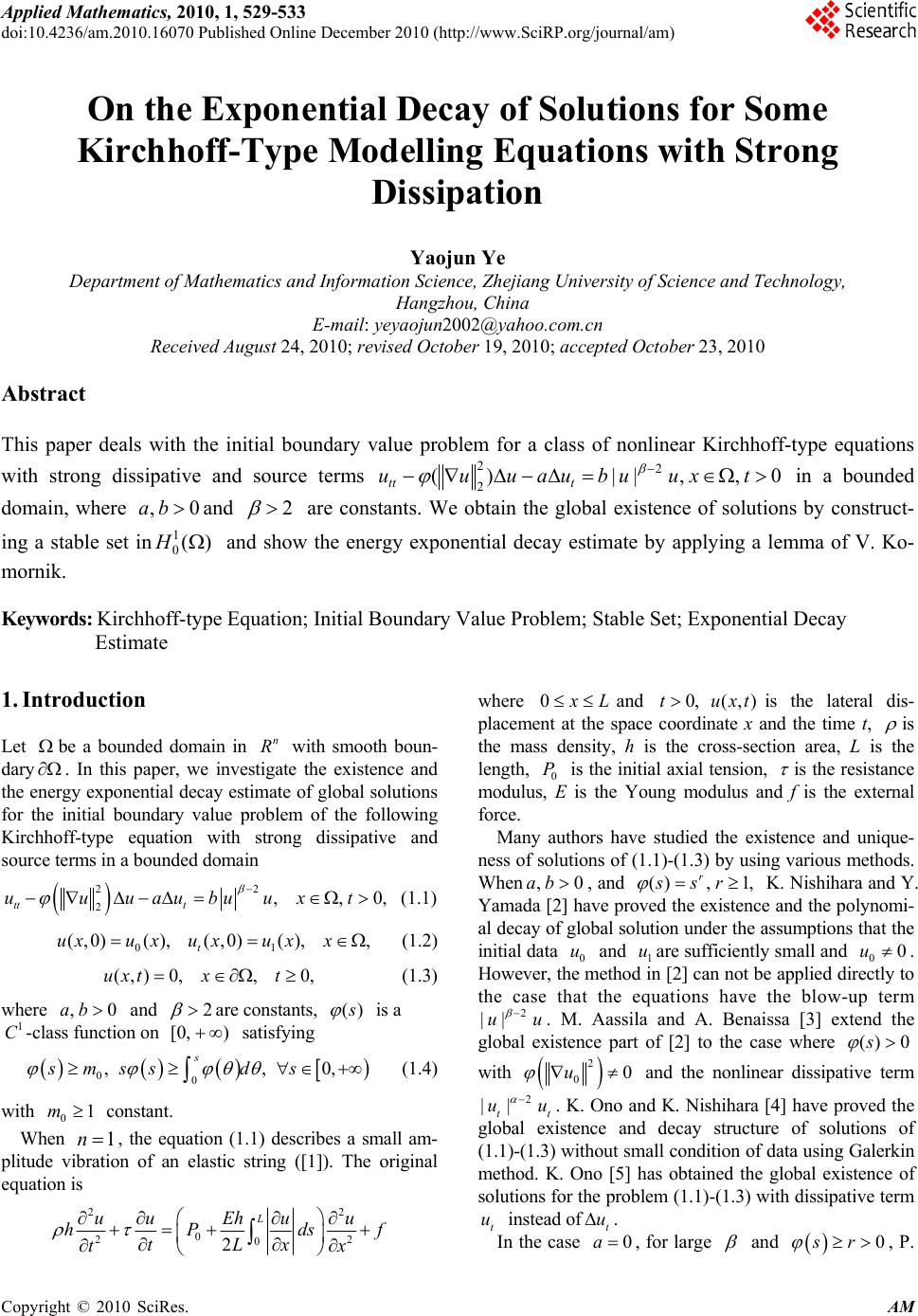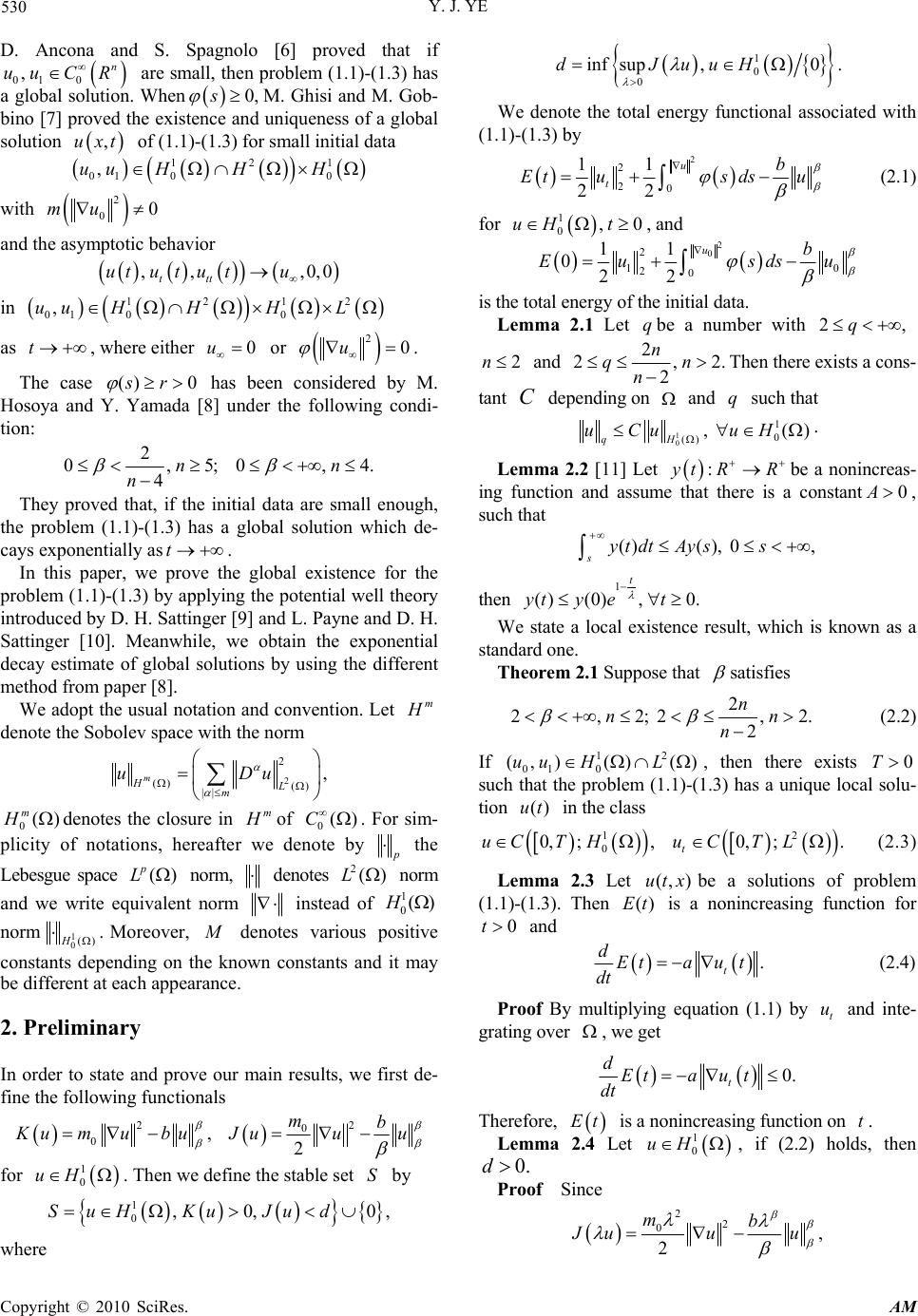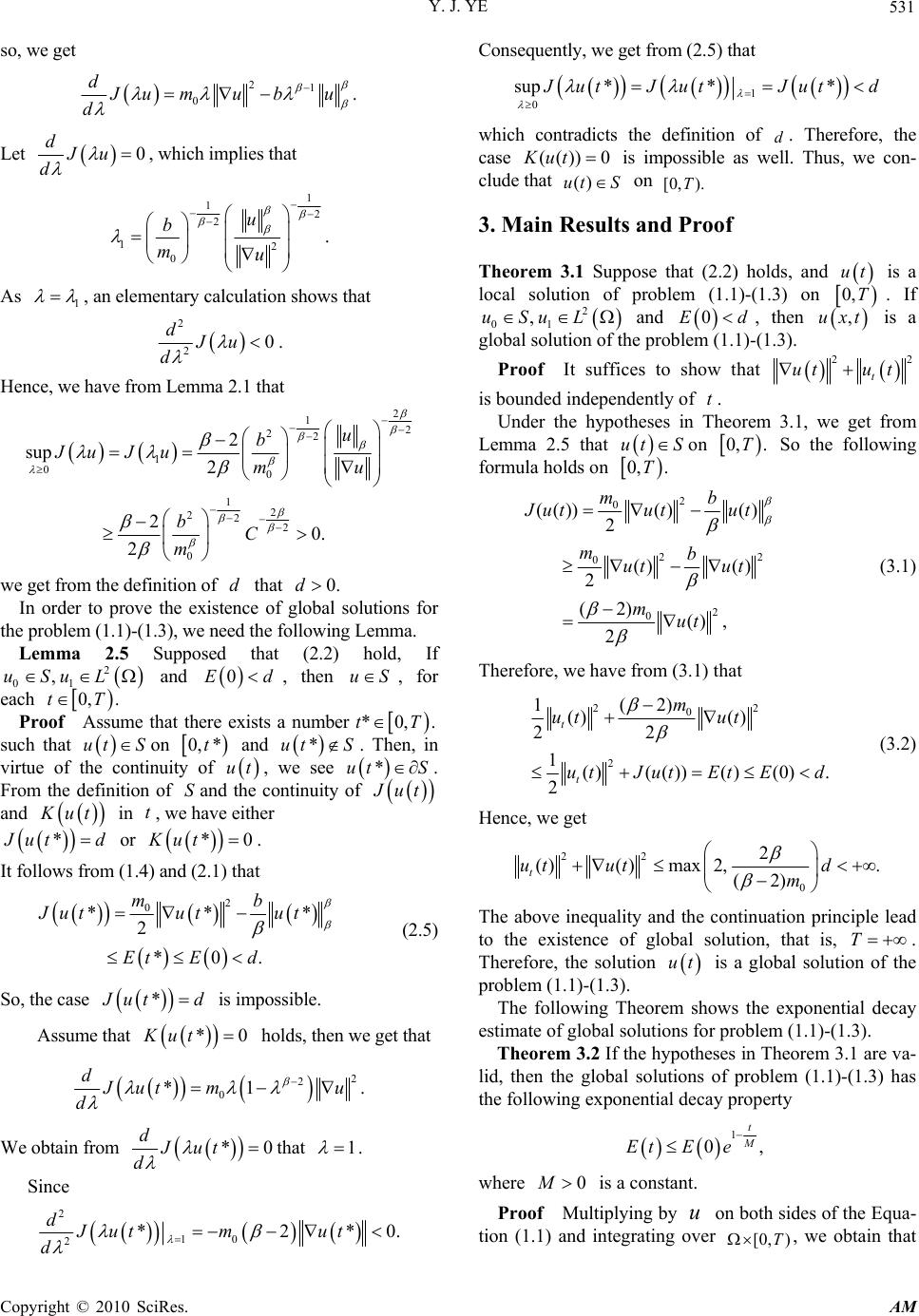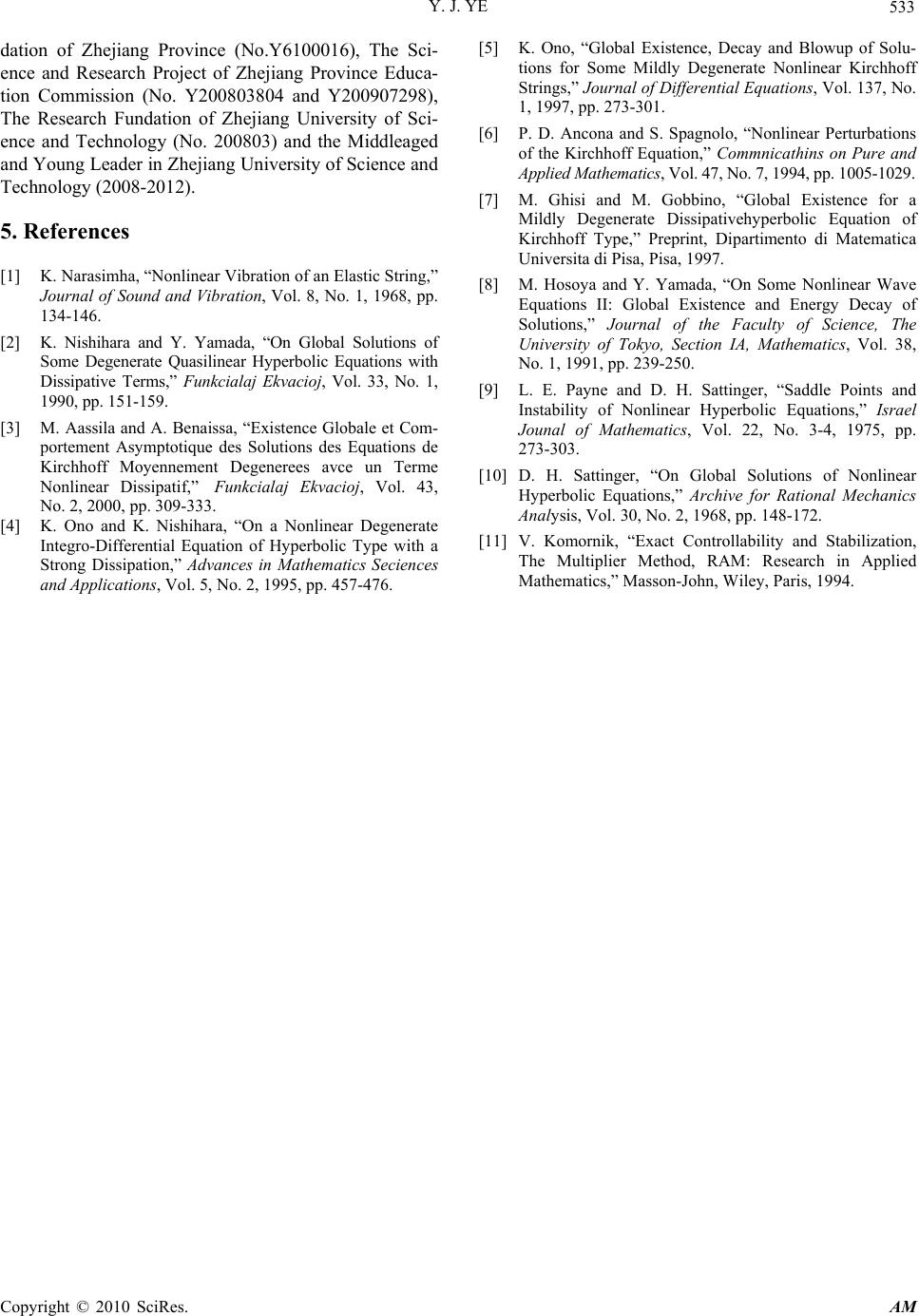Paper Menu >>
Journal Menu >>
 Applied Mathematics, 2010, 1, 529-533 doi:10.4236/am.2010.16070 Published Online December 2010 (http://www.SciRP.org/journal/am) Copyright © 2010 SciRes. AM On the Exponential Decay of Solutions for Some Kirchhoff-Type Modelling Equations with Strong Dissipation Yaojun Ye Department of Math ematics and Informa tion Science, Zhejiang University of Science and Technology, Hangzhou, China E-mail: yeyaojun2002@yahoo.com.cn Received August 24, 2010; revised October 19, 2010; accepted October 23, 2010 Abstract This paper deals with the initial boundary value problem for a class of nonlinear Kirchhoff-type equations with strong dissipative and source terms 22 2 () ||,,0 tt t uuuaubuuxt in a bounded domain, where ,0aband 2 are constants. We obtain the global existence of solutions by construct- ing a stable set in1 0()H and show the energy exponential decay estimate by applying a lemma of V. Ko- mornik. Keywords: Kirchhoff-type Equation; Initial Boundary Value Problem; Stable Set; Exponential Decay Estimate 1. Introduction Let be a bounded domain in n R with smooth boun- dary. In this paper, we investigate the existence and the energy exponential decay estimate of global solutions for the initial boundary value problem of the following Kirchhoff-type equation with strong dissipative and source terms in a boun ded do m a i n 22 2,,0, tt t uuuaubuuxt (1.1) 01 (,0)(),(,0)(),, t ux uxux uxx (1.2) (,) 0,,0,uxt xt (1.3) where ,0ab and 2 are constants, () s is a 1 C-class function on [0, ) satisfying 00 ,,0, s smssd s (1.4) with 01m constant. When 1n, the equation (1.1) describes a small am- plitude vibration of an elastic string ([1]). The original equation is 22 0 22 0 2 L uuEhu u hPdsf tLx tx where 0 x L and 0,t(,)uxt is the lateral dis- placement at the space coordinate x and the time t, is the mass density, h is the cross-section area, L is the length, 0 P is the initial axial tension, is the resistance modulus, E is the Young modulus and f is the external force. Many authors have studied the existence and unique- ness of solutions of (1.1)-(1.3) by using various methods. When ,0ab, and (), 1, r ssr K. Nishihara and Y. Yamada [2] have proved the existence and the polynomi- al decay of global solution under the assumptions that the initial data 0 u and 1 uare sufficiently small and 00u . However, the method in [2] can not be applied directly to the case that the equations have the blow-up term 2 ||uu . M. Aassila and A. Benaissa [3] extend the global existence part of [2] to the case where () 0s with 2 00u and the nonlinear dissipative term 2 || tt uu . K. Ono and K. Nishihara [4] have proved the global existence and decay structure of solutions of (1.1)-(1.3) without small condition of data using Galerkin method. K. Ono [5] has obtained the global existence of solutions for the problem (1.1)-(1.3) with dissipative term t u instead oft u . In the case 0a , for large and 0sr , P.  Y. J. YE Copyright © 2010 SciRes. AM 530 D. Ancona and S. Spagnolo [6] proved that if 01 0 ,n uuC R are small, then problem (1.1)-(1.3) has a global solution. When 0,s M. Ghisi and M. Gob- bino [7] proved the existence and uniqueness of a global solution ,uxt of (1.1)-(1.3) for small initial data 121 01 00 ,uu HHH with 2 00mu and the asymptotic behavior , ,,0,0 ttt utu tutu in 1212 01 00 ,uu HHHL as t, where either 0u or 20u . The case () 0sr has been considered by M. Hosoya and Y. Yamada [8] under the following condi- tion: 2 0,5;0,4. 4nn n They proved that, if the initial data are small enough, the problem (1.1)-(1.3) has a global solution which de- cays exponentially ast. In this paper, we prove the global existence for the problem (1.1) -(1.3) by applying the potential well theory introduced by D. H. Sattinger [9] and L. Payne and D. H. Sattinger [10]. Meanwhile, we obtain the exponential decay estimate of global solutions by using the different method from paper [8]. We adopt the usual notation and convention. Let m H denote the Sobolev space with the norm 2 2 () () || , m HL m uDu 0() m Hdenotes the closure in m H of 0()C. For sim- plicity of notations, hereafter we denote by p the Lebesgue space () p L norm, denotes 2()L norm and we write equivalent norm instead of 1 0()H norm 1 0() . H Moreover, M denotes various positive constants depending on the known constants and it may be different at each appeara nc e. 2. Preliminary In order to state and prove our main results, we first de- fine the following functionals 2 0, K umu bu 2 0 2 mb J uuu for 1 0 uH. Then we define the stable set S by 1 0,0, 0,SuHKuJud where 1 0 0 inf sup,0dJuuH . We denote the total energy functional associated with (1.1)-(1.3) by 2 2 20 11 22 u tb Etusds u (2.1) for 1 0,0uH t , and 2 0 2 10 20 11 022 ub Eu sdsu is the total energy of the initial data. Lemma 2.1 Let qbe a number with 2,q 2n and 2 2,2. 2 n qn n Then the re exists a cons - tant C depending on and q such that 1 0 1 0 () ,() qH uCu uH . Lemma 2.2 [11] Let :yt RR be a nonincreas- ing function and assume that there is a constant0A, such that () (),0, sytdt Ayss then 1 () (0),0. t yty et We state a local existence result, which is known as a standard one. Theorem 2.1 Suppose that satisfies 2 2,2;2 ,2. 2 n nn n (2.2) If 12 01 0 (,)()()uu HL , then there exists 0T such that the problem (1.1)-(1.3) has a unique local solu- tion ()ut in the class 12 0 0, ;,0, ;. t uC THuC TL (2.3) Lemma 2.3 Let (, )utx be a solutions of problem (1.1)-(1.3). Then ()Et is a nonincreasing function for 0t and . t dEtau t dt (2.4) Proof By multiplying equation (1.1) by t u and inte- grating over , we get 0. t dEtau t dt Therefore, Et is a nonincreasing function on t. Lemma 2.4 Let 1 0 uH , if (2.2) holds, then 0.d Proof Since 22 0, 2 mb J uuu  Y. J. YE Copyright © 2010 SciRes. AM 531 so, we get 21 0. d J umu bu d Let 0 dJu d , which implies that 1 12 2 12 0 . u b mu As 1 , an elementary calculation shows that 2 20 dJu d . Hence, we have from Lem ma 2.1 that 2 12 22 1 00 12 222 0 2 sup 2 20. 2 u b JuJ uu m bC m we get from t he definit i on of d that 0.d In order to prove the existence of global solutions for the problem (1.1)-(1. 3), we need the following Lemma. Lemma 2.5 Supposed that (2.2) hold, If 2 01 ,uSuL and 0Ed, then uS , for each 0, .tT Proof Assume that there exists a number *0,.tT such that ut Son 0, *t and *utS. Then, in virtue of the continuity of ut, we see *utS . From the definition of Sand the continuity of J ut and K ut in t, we have either * J ut d or *0Kut . It follows from (1.4) and (2.1) that 2 0 *** 2 *0. mb Jutut ut Et Ed (2.5) So, the case * J ut d is impossible. Assume that *0Kut holds, then we get that 2 2 0 *1 . d J ut mu d We obtain from *0 dJut d that 1 . Since 2 10 2*2*0. dJut mut d Consequently, we get from (2.5) that 1 0 sup *** J utJ utJutd which contradicts the definition of d. Therefore, the case (()) 0Kut is impossible as well. Thus, we con- clude that ()ut S on [0, ).T 3. Main Results and Proof Theorem 3.1 Suppose that (2.2) holds, and ut is a local solution of problem (1.1)-(1.3) on 0,T. If 2 01 ,uSuL and 0Ed, then ,uxt is a global solu tion of the problem (1.1)-(1.3 ). Proof It suffices to show that 22 t utu t is bounded independently of t. Under the hypotheses in Theorem 3.1, we get from Lemma 2.5 that ut S on 0, .T So the following formula holds on 0, .T 2 0 22 0 2 0 (())() () 2 () () 2 (2) () , 2 mb J utut ut mb ut ut mut (3.1) Therefore, we have from (3.1) that 22 0 2 (2) 1() () 22 1()( ())()(0). 2 t t m ut ut utJutEt Ed (3.2) Hence, we get 22 0 2 ()()max2,. (2) t ut utd m The above inequality and the continuation principle lead to the existence of global solution, that is, T . Therefore, the solution ut is a global solution of the problem (1.1)-(1.3). The following Theorem shows the exponential decay estimate of global solutions for problem (1.1)-(1.3). Theorem 3.2 If the hypo theses in Theor em 3.1 ar e va- lid, then the global solutions of problem (1.1)-(1.3) has the following expon ential decay property 1 0, t M Et Ee where 0M is a constant. Proof Multiplying by u on both sides of the Equa- tion (1.1) and integrating over [0, )T , we obtain that  Y. J. YE Copyright © 2010 SciRes. AM 532 22 2 0||, T tt t Suuuua ubuudxdt (3.3) where 0.ST Since 2. TT T ttt St SS uudxdtuu dxudxdt (3.4) So, substituting the Formula (3.4) into the right-hand side of (3.3), we get that 222 2 2 2 0 2 21. T t S T tt S T T tS S b uuuudt uauu dxdt uu dxbudt (3.5) It follows from (3.2) that 2 00 0 22 2 0 222 utEt Ed mm m (3.6) By exploiting Lemma 2.1 and (3.6), we easily arrive at 22 2 22 0 2, 2 bubC utbCutut bCdu t m (3.7) We obtain from (3.6) and (3.7) that 2 22 0 2 2 00 2 2 00 222 1() (2) 222 () (2)(2) 22 (). (2) bubC d ut m bCdE t mm bC dEt mm (3.8) We derive from (1.4) that 222 0, u s dsuu (3.9) It follows fro m (3.5), (3.8) and (3.9) that 2 2 00 2 2 21 2 2| |. T S TT tt tS S bC dEtdt mm uauudxdtuu dx (3.10) We have from Lemma 2.1 and (3.2) that 2 2 222 0 0 2 0 11 22 21 222 max ,1, 2 TT tStS T tS T S uu dxuu m Cuu m CEt MES m (3.11) Substituting the estimate (3.11) into (3.10), we conclude that 2 2 00 2 22 21 2 2. T S T tt S bC dEtdt mm uauudxdtMES (3.12) We get from Lemma 2.1 and Lemma 2.3 that 22 2 2 22 222 22 . TTT tt t SSS udxdtudt Cudt CC ET ESES aa (3.13) From Young inequality, Lemma 2.1, Lemma 2.3 and (3.6), We receive that 22 0 0 2 2 2. 2 TT tt SS T S T S au udxdtauMudt aEtdtMESET m aEtdtMES m (3.14) Choosing small enough such that 2 2 00 0 22 1, 22 abCd mm m then, substituting (3.13) and (3.14) into (3.12), . T SEtdt MES (3.15) Let T, then we have from (3.15) that . SEtdt MES (3.16) Thus, we receive from (3.16) and Lemma 3.1 that 1 0,0,. t M Et E et (3.17) The proof of Theorem 3.2 is finished. 4. Acknowledgments This Research was supported by Natural Science Foun-  Y. J. YE Copyright © 2010 SciRes. AM 533 dation of Zhejiang Province (No.Y6100016), The Sci- ence and Research Project of Zhejiang Province Educa- tion Commission (No. Y200803804 and Y200907298), The Research Fundation of Zhejiang University of Sci- ence and Technology (No. 200803) and the Middleaged and Young Leader in Zhejiang University of Science an d Technology (2008-2012). 5. References [1] K. Narasimha, “Nonlinear Vibration of an Elastic String,” Journal of Sound and Vibration, Vol. 8, No. 1, 1968, pp. 134-146. [2] K. Nishihara and Y. Yamada, “On Global Solutions of Some Degenerate Quasilinear Hyperbolic Equations with Dissipative Terms,” Funkcialaj Ekvacioj, Vol. 33, No. 1, 1990, pp. 151-159. [3] M. Aassila and A. Benaissa, “Existence Globale et Com- portement Asymptotique des Solutions des Equations de Kirchhoff Moyennement Degenerees avce un Terme Nonlinear Dissipatif,” Funkcialaj Ekvacioj, Vol. 43, No. 2, 2000, pp. 309-333. [4] K. Ono and K. Nishihara, “On a Nonlinear Degenerate Integro-Differential Equation of Hyperbolic Type with a Strong Dissipation,” Advances in Mathematics Seciences and Applications, Vol. 5, No. 2, 1995, pp. 457-476. [5] K. Ono, “Global Existence, Decay and Blowup of Solu- tions for Some Mildly Degenerate Nonlinear Kirchhoff Strings,” Journal of Differential Equations, Vol. 137, No. 1, 1997, pp. 273-301. [6] P. D. Ancona and S. Spagnolo, “Nonlinear Perturbations of the Kirchhoff Equation,” Commnicathins on Pure and Applied Mathematics, Vol. 47, No. 7, 1994, pp. 1005-1029. [7] M. Ghisi and M. Gobbino, “Global Existence for a Mildly Degenerate Dissipativehyperbolic Equation of Kirchhoff Type,” Preprint, Dipartimento di Matematica Universita di Pisa, Pisa, 1997. [8] M. Hosoya and Y. Yamada, “On Some Nonlinear Wave Equations II: Global Existence and Energy Decay of Solutions,” Journal of the Faculty of Science, The University of Tokyo, Section IA, Mathematics, Vol. 38, No. 1, 1991, pp. 239-250. [9] L. E. Payne and D. H. Sattinger, “Saddle Points and Instability of Nonlinear Hyperbolic Equations,” Israel Jounal of Mathematics, Vol. 22, No. 3-4, 1975, pp. 273-303. [10] D. H. Sattinger, “On Global Solutions of Nonlinear Hyperbolic Equations,” Archive for Rational Mechanics Analysis, Vol. 30, No. 2, 1968, pp. 148-172. [11] V. Komornik, “Exact Controllability and Stabilization, The Multiplier Method, RAM: Research in Applied Mathematics,” Masson-John, Wiley, Paris, 1994. |

